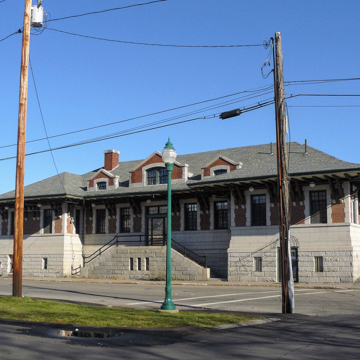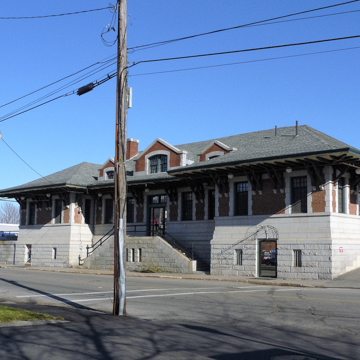You are here
Gardiner Railroad Station
Maine Central’s station in Gardiner is one of the most elegant surviving train stations in Maine. Train service arrived in Gardiner in 1852, and this station was built in 1911 to replace its nineteenth-century predecessor, located just to the south. Situated overlooking the Kennebec River, Gardiner Station was designed by George Burnham. Together with the Cumberland County Courthouse (1904) and the Burnham and Morrill factory (1913), the station is one of the little known architect’s signature works in Maine.
Born in Portland, Burnham graduated from the Massachusetts Institute of Technology and worked in both Boston and New York before returning to his hometown in 1902. The one-and-a-half-story Gardiner Station marked the start of his second decade in Maine. Like the recently completed Portland City Hall by the New York firm of Carrêre and Hastings, Burnham used a Renaissance Revival design. The light-colored granite for the foundation and window surrounds contrasts delightfully with the station’s red brick walls. The structure’s low-pitched hipped roof has wide, overhanging eaves supported by paired brackets, all emblematic of the fashionable Renaissance style. The five-bay facade faces west, onto what had originally been the train platform. It features the ticket booth (faced entirely in granite), shielded by the overhanging hipped roof from which protrude three prominent dormers with low-arched windows, the largest centrally placed and flanked on either side by a smaller dormer. The building has one internal chimney.
Abandoned by the Maine Central in the late 1950s, the building served for several years as an auto parts store, and then various commercial purposes. The train tracks behind the station are now part of a six-and-a-half rail trail that connects Augusta and Gardiner. The station itself is now home to the Wellness Connection of Maine, a medical marijuana dispensary.
References
Beard, Frank A., “Gardiner Railroad Station,” Kennebec County, Maine. National Register of Historic Places Inventory–Nomination Form, 1982. National Park Service, U.S. Department of Interior, Washington, D.C.
Reed, Roger G., “George Burnham,” In A Biographical Dictionary of Architects in Maine, edited by Earle G. Shettleworth Jr. and Roger G. Reed. Last updated 2006. Accessed September 1, 2015. http://www.maine.gov/ .
Reed, Roger G. “Railroad Passenger Stations in Maine: An Overview of their Architectural Development.” In Along the Rails: A Survey of Maine’s Historic Railroad Buildings, edited by Kirk F. Mohoney .Augusta: Maine Historic Preservation Commission, 2000.
Writing Credits
If SAH Archipedia has been useful to you, please consider supporting it.
SAH Archipedia tells the story of the United States through its buildings, landscapes, and cities. This freely available resource empowers the public with authoritative knowledge that deepens their understanding and appreciation of the built environment. But the Society of Architectural Historians, which created SAH Archipedia with University of Virginia Press, needs your support to maintain the high-caliber research, writing, photography, cartography, editing, design, and programming that make SAH Archipedia a trusted online resource available to all who value the history of place, heritage tourism, and learning.

















